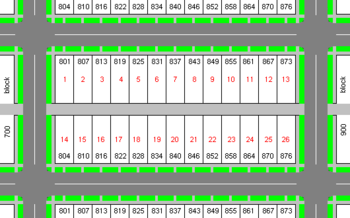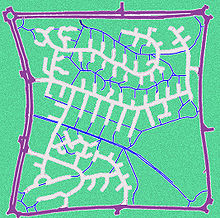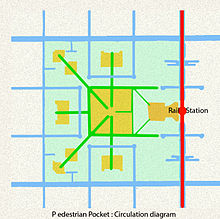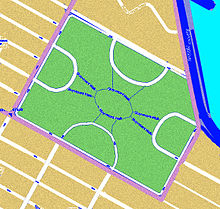- City block
-
Diagram of an example of a rectangular city block as seen from above, surrounded by streets. The block is divided into lots which were numbered by the developer as shown in red here and as shown in plats. The addresses on this example 800 block are shown in black and the adjacent blocks are the 700 and 900 blocks. An alley shown in light gray runs lengthwise down the middle of the block. Streets are shown in dark gray. Sidewalks are shown in light gray. Parkways are shown in green with walkways shown in light gray from every lot to the street.

A city block, urban block or simply block is a central element of urban planning and urban design. A city block is the smallest area that is surrounded by streets. City blocks are the space for buildings within the street pattern of a city, they form the basic unit of a city's urban fabric. City blocks may be subdivided into any number of smaller lots or parcels of land usually in private ownership, though in some cases, it may be other forms of tenure. City blocks are usually built-up to varying degrees and thus form the physical containers or 'streetwalls' of public space. Most cities are composed of a greater or lesser variety of sizes and shapes of urban block. For example, many pre-industrial cores of cities in Europe, Asia and the Middle-east tend to have irregularly shaped street patterns and urban blocks, while cities based on grids have much more regular arrangements.
Contents
Grid plan
In most cities of the world that were planned, rather than developing gradually over a long period of time, streets are typically laid out on a grid plan, so that city blocks are square or rectangular. Using the perimeter block development principle, city blocks are developed so that buildings are located along the perimeter of the block, with entrances facing the street, and semi-private courtyards in the rear of the buildings.[1] This arrangement is intended to provide good social interaction among people.[1]
Since the spacing of streets in grid plans varies so widely among cities, or even within cities, it is difficult to generalize about the size of a city block. However, as reference points,the standard square blocks of Portland, Houston and Sacramento are 260 by 260 feet (79 × 79 m), 330 by 330 feet (100 × 100 m) and 410 by 410 feet (120 × 120 m) respectively (to the street center line). Oblong blocks range considerably in width and length. The standard block in Manhattan is about 264 by 900 feet (80 × 270 m); and in some U.S. cities standard blocks are as wide as 660 feet (200 m). The blocks in central Melbourne, Australia, are 660 by 330 feet (200 × 100 m), formed by splitting the square blocks in an original grid with a narrow street down the middle.
Many world cities have grown by accretion over time rather than being planned from the outset. For this reason, a regular pattern of even, square or rectangular city blocks is not so common among European cities, for example. Following the example of Philadelphia, New York City adopted the Commissioners' Plan of 1811 for a more extensive grid plan. By the middle of the 20th century, the adoption of the uniform, rectilinear block, subsides almost completely and more picturesque layouts prevailed, with random sized and either curvilinear or non-orthogonal blocks and corresponding street patterns.
In much of the United States and Canada, the addressing systems follow a block and lot number system, in which each block of a street is allotted 100 building numbers.
Use of block as a unit of distance
In North American English the term block is used as an informal unit of distance; for example, when giving directions (e.g. "It's three blocks from here.").
In British English the term is scarcely used to convey a measure of distance due to the lack of 'blocks' in most cities; it is, however, used when making short trips around a nearby road of an estate. (e.g. "I'm taking the dog out for a walk around the block")
Superblock
Superblocks were popular during the early and mid-20th century, arising from modernist ideas in architecture and urban planning. A superblock is much larger than a traditional city block, with greater setback for buildings, and is typically bounded by widely spaced, high-speed, arterial or circulating routes rather than by local streets. Superblocks are often associated with suburbs, planned cities, and the urban renewal of the mid-20th century; that is, in areas in which a street hierarchy has replaced the traditional grid. In a residential area of a suburb, the interior of the superblock is typically served by cul-de-sac or looped streets. Superblocks can also be found in central city areas, where they are more often associated with institutional, educational, recreational and corporate rather than residential uses.Urban planner Clarence Perry argued for use of superblocks and related ideas in his "neighborhood unit" plan, which aimed to organize space in a way that is more pedestrian-friendly and provided open plazas and other space for residents to socialize.[2] The same intention to facilitate pedestrian movement and socializing is captured by an influential 1989 conceptual design of a Pedestrian Pocket[3](see diagram). It is, similarly, a superblock composed of nine normal city blocks clustered around a light rail station and a central open space. Its circulation pattern consists primarily of a dense pedestrian network which is complementary to but independent from the car network. Access by car is provided by means of three loops. This superblock differs from Perry’s concept in that it makes it impossible for cars to traverse it rather than very difficult; it is car-impermeable.
In the 1930s, superblocks were often used in urban renewal public housing projects in American cities.[4] In using superblocks, housing projects aimed to eliminate back alleys, which were often associated with slum conditions.[4]
Superblocks are also used when functional units such as rail yards or shipyards, inherited from the 19th and early 20th centuries, are too big to fit in an average city block. A contemporary function which reflects ancient practices that also requires larger than typical blocks is the sports stadium or arena. Just as the Coliseum in ancient Rome, sports complexes require superblocks. The PGE Stadium in Portland, for example, takes up six normal city blocks as does the equally large Greensboro Coliseum in North Carolina. Other contemporary institutions, establishments or functions that require superblocks are: city halls, as in Boston and Toronto; regional general hospitals or specialized medical centres; convention and exhibition centers, as the CNE in Toronto and Boston; and downtown enclosed Shopping Malls such as Eaton Centre in Toronto, echoing the large gallerias of the 19th century. Cultural complexes, such as the Lincoln Centre in NY, often occupy a superblock achieved through the consolidation of regular city blocks. A recent superblock user is the merchandise distribution centre. These centres can range in area from one to ten city blocks.
Most notably, however, the largest superblocks in contemporary cities are used by university and college campuses such as Massachusetts Institute of Technology, the University of Illinois at Chicago the City College of New York, Columbia University and the University of Alberta in Edmonton. The “campus” impact on the city block structure is quite prominent particularly in small university towns such as Waterloo, Ontario or Ithaca, NY where the university superblock counts for a sizeable portion of the total city area. Campuses, in general, are fully walkable and sociable environments within the superblock structure.
Additional users of the superblock concept are contemporary large national or multinational corporations who followed the “campus” model and introduced their own superblocks in cities, as Google did in Mountain view, CA, IBM in Somers, NY and Apple and HP in San Jose, CA.
Social and housing agencies in the US, Canada and the UK used the superblock model for large housing projects such as Regent Park in Toronto and Benny Farm in Montreal, Canada. In New York City, the Stuyvesant Town private market, residential development superblock takes up about 18 normal city blocks and provides a large green amenity for its residents and neighbours. It uses crescent (loop) rather than cul-de-sac streets inside the superblock and an extensive network of paths that provide excellent connectivity within the block and to the neighbouring areas (see drawing).
A well-known example of a superblock is the World Trade Center site in New York City, where several streets of Manhattan's downtown grid were removed and de-mapped to make room for the center.
Where the superblock is used for housing projects, such as the Stuyvesant Town the advantages sought are an improved separation of vehicular and pedestrian circulation, enhanced tranquility and reduced accident risk within the neighbourhood. This separation has been achieved with exemplary environmental and social benefits in a new (2003), internationally recognized,[5] rail suburb of Freiburg,Germany - Vauban. Its site layout consists mainly of a superblock with a central pedestrian spine and a few narrow looped and cul-de-sac streets. The same separation can be found on many university and college campuses which are generally considered as vibrant, socially thriving communities. On some university campuses the extensive and exclusive pedestrian path network at grade is supplemented with below grade paths. New Urbanists would argue that separating circulation modes effectively kills the social interaction that bolsters urban areas. The British new town of Milton Keynes is built around a grid of one-kilometre square superblocks.(see drawing)
For functional, organizational, economic and planning reasons the superblock model continues to be used extensively.
Unplanned, emergent superblocks
Virtual, unplanned superblocks have emerged in many cities worldwide as the inevitable outcome of stepwise modifications to streets and traffic. Most such superblocks have occurred in European city centres where the street network originates in the medieval or earlier periods. Not only is the street pattern labyrinthine, but also numerous streets that constitute it have dimensions incapable of accommodating two crossing cars or one car and pedestrians, excluding the need for parking or emergency access. Such geometric constraints and the resulting chaotic traffic conditions, along with deteriorating air quality, forced cities to remove motorized traffic from such streets. In certain cases, such as the city of Bremen, Germany, the cumulative effect of excluding motorized traffic from a number of streets made it impossible to cross the old city centre by car. The centre, however, remains completely traversable on foot or bicycle; a condition that resembles in principle the planned superblock and incorporates its design intentions. Some cities, such as Montpellier, France expanded the exclusion of traffic from the entire old centre. The superblock concept has also been applied retroactively in Barcelona’s Ribera and Gracia districts with positive outcomes. In these two cases it resulted in an increase of journeys on foot (>10%) and by bicycle (>15%) and in higher level of commercial and service activity.[6] The concept is now being considered for application on Idelfonse Cerdà’s grid.
Perimeter block
A perimeter block is a type of city block which is built up on all sides surrounding a central space that is semi-private. They may contain a mixture of uses, with commercial or retail functions on the ground floor. Perimeter blocks are a key component of many European cities and are an urban form that allows very high urban densities to be achieved without high-rise buildings.
Online uses of blocks
There have been online innovations and websites such as msnbc.com owned EveryBlock which uses geo-specific feeds from neighborhood blogs, Flickr, Yelp, Craigslist, Youtube, Twitter, Facebook and other aggregated data to give readers a picture of what is going on in their town or neighborhood down to the block.[7]
See also
- Census block
- Manhattan distance
- Mixed-use development
- Urban design
- Urban planning
- Mile Road System of Metro Detroit Region
References
- ^ a b Frey, Hildebrand Frey (1999). Designing the City: Towards a More Sustainable Urban Form. E & FN Spon. ISBN 0419221107.
- ^ Keating, W. Dennis, Norman Krumholz (2000). "Neighborhood Planning". Journal of Planning Education and Research 20 (1): p. 111–114. doi:10.1177/073945600128992546.
- ^ http://www.calthorpe.com/publications/pedestrian-pocket-book-new-suburban-design-strategy
- ^ a b Ben-Joseph, Eran, Terry S. Szold (2005). Regulating Place: Standards and the Shaping of Urban America. Routledge. ISBN 0415948746.
- ^ Commission for Architecture and the Built Environment http://www.cabe.org.uk/case-studies/vauban
- ^ Salvador Rueda 2010,Sustainable Urban Expansions: the Legacy of the Cerdà Plan
- ^ http://www.cmswire.com/cms/web-publishing/web-publishing-rollup-rise-and-advise-005321.php
Further reading
- Jacobs, Jane (1961). The Death and Life of Great American Cities. Random House.
Real estate developments Commercial Business park · Office building · Ports and waterfronts · Retail park · Shopping mall / center · Shopping streets and districts · Warehouse DistrictIndustrial Residential Science / Education Municipal Buildings Miscellaneous Categories:- Urban studies and planning terminology
- Urban design
Wikimedia Foundation. 2010.





